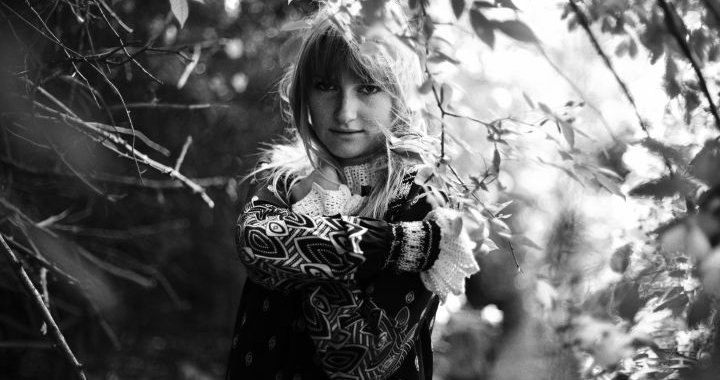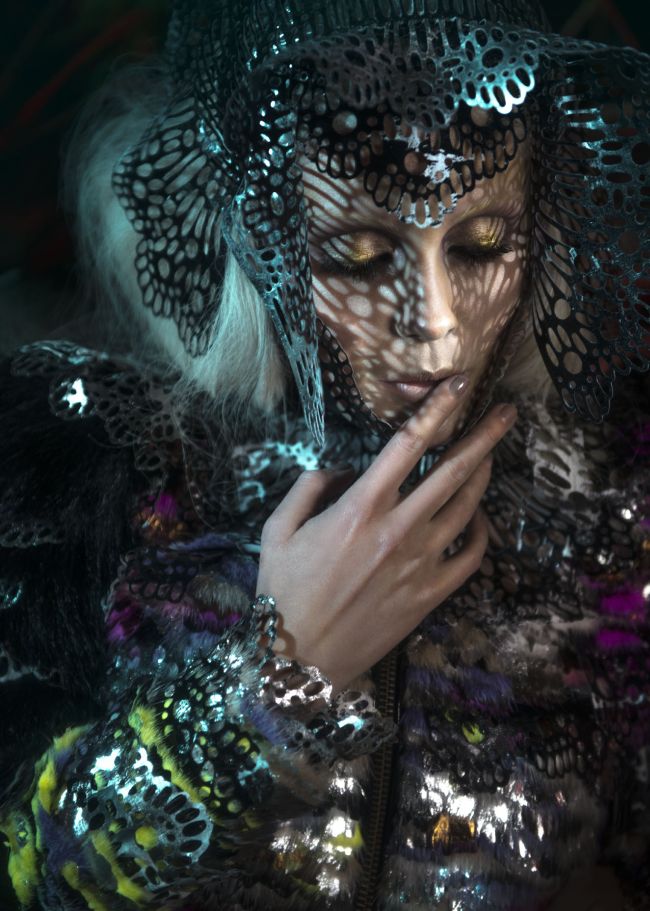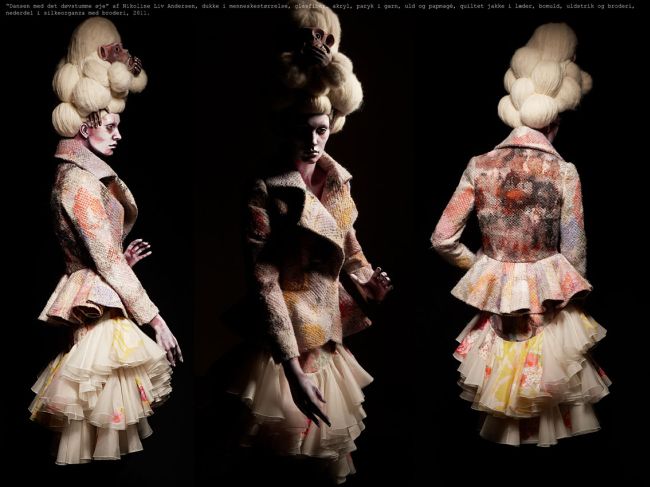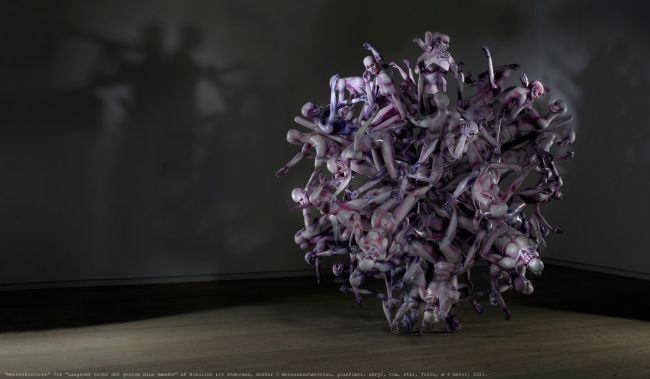
The Secret Universe of Nikoline Liv Andersen
Lizete Riņķe
17/02/2014
The exhibition, Only Angels Have Wings will be on view at the Horsens Museum of Modern Art, from May 24.
The scenario is barren and dimly lit.
The sun has set a long time ago, without anyone noticing.
They only realize this when it’s dark and another day
has passed.
For every day, time goes faster and bears testimony
to the fact that the heart only beats for a while.
They know this.
But there is no way around it.
It gets more and more cold and everything withers.
Nature is dead.
Its term of existence is forgotten.
Without nature, no man.
They know this.
In a remote place, a scientist stands by his machine.
He Knows.
Artificial nature is produced – hoping for survival,
hoping for eligibility, hoping to turn evolution around.
It’s man fighting for life, fighting for nature,
fighting himself.
The above poem was written by Danish fashion designer Nikoline Liv Andersen. It is part of her latest project, Only Angels Have Wings, which is currently being exhibited at the Danish Design Centre in Copenhagen; in the spring, it will be presented at the Horsens Museum of Modern Art (this will be her second exhibition at Horsens). The project was also exhibited at the Martin Asbæk Gallery during Copenhagen Fashion Week, at the end of January.
It is not often that you meet a fashion designer who writes poems as a part of a collection. But Nikoline Liv Andersen is definitely not a typical fashion designer – it is, in fact, difficult to define her work as fashion, or at least with what we traditionally associate as being fashion. Since she graduated from the Danish Design School seven years ago, she has followed her own path without regard to the change of the seasons, trends, sales' numbers, or other conventions of the fashion industry. During her studies, she also had an internship with John Galliano and Christian Dior in Paris, where she worked both with haute couture and prêt-a-porter. Her creations can be placed somewhere in the borderlands between fashion, design and art.
Nikoline Liv Andersen works with unusual materials and material combinations, such as fabric, wool, leather and fur, but also with plastic, and sometimes even nails and darning needles. Andersen experiments with surface and form, and builds with layers of different materials – at times embroidering and painting on them. Drinking straws are one of these unusual materials that she has worked with, particularly in her latest projects, and she creates highly sculptural pieces with them. In her previous project, The Dance of the Deaf and Dumb Eye, an entire dress was constructed from straws. She plays with materials, forms and texture, thus challenging our perception of the material in a way that makes one think of the American artist, Tara Donovan.
Her pieces are one-of-a-kind and executed by hand, which is a slow and demanding process; they are the closest you can come to haute couture in Denmark. Nikoline Liv Andersen does not just design clothing – she tells stories with her creations. She stages her design as an element of a sculptural installation, and thus builds an entire universe around her pieces – a universe that is at once obscure, mysterious and dramatic, and infused with delicate beauty, poetry and humor. The project, Only Angels Have Wings, was one of four nominees for the Danish fashion award DANSK Design Talent Magasin Award, which was created last year to support creative and emerging designers who lean towards a more experimental direction.

Only Angels Have Wings. 2013. Photo: Signe Vilstrup
I met Nikoline Liv Andersen at the Danish Design Centre shortly before the exhibition's opening, while she was still putting on the finishing touches to the exposition – together with her two trainees and her husband, who is a designer and also her assistant. The exposition mainly consists of mannequins that seem to float in the air and above the floor, bearing Andersen's creations; there are also a number of smaller mannequins representing angels, as well as large photos of her projects.
Nikoline Liv Andersen tells me a little about the concept behind her project. Her point of departure is a story that she has written, a kind of dystopian, futuristic narrative: “It is a story of a city where people have forgotten about the reason for their existence. They have destroyed all nature, and so the Earth is coming to its end. However, in the city there is a scientist who has built a machine with which he fabricates artificial nature – so as to legitimize the humans' existence. The mannequins represent this artificial nature. The mannequins are from Hindsgaul, and I have cut them into pieces and given them new joints and artificial limbs; in a way, they are my Androids.”
So, you seem to be inspired by science fiction in your project; in particular, Ridley Scott’s Blade Runner comes to mind.
Yes, definitely! It is one of the things that I had in the beginning, hanging on my wall. I always work with dolls of some kind; even though these are not actually dolls, but mannequins, I still call them dolls. In general, I love to work with dolls because there is something realistic about them, but at the same time, they are artificial – I love the contrast. There is also something frightening about them. I like to customize them, and I also like to stage my clothing, and for that, they are perfect. I paint on them and cut them up – it is important for me to make them my own. But the most important part of this project is the work with the materials.

Only Angels Have Wings. 2013. Photo: Signe Vilstrup
How do you choose the materials that you work with, and what kind of materials did you use in the project?
It is always a long experiment with the materials. I continue on until I reach the magic moment. In this project, I have worked particularly with artificial materials – with various industrially-produced materials that I have worked on in such a way that they begin to look organic. Among other things, I have worked with drinking straws and pop rivets; I am crazy about drinking straws – there is such a nice mood surrounding them, but they are also a fantastic material to work with; they give you so many possibilities. I have also used some organic materials, such as fur (which I get from Saga Furs), which, in contrast, I make look as if it's artificial. I have also used cotton and leather, which I have quilted. I have made layers of silver leather and cotton that I have colored and quilted, and then ripped up and combed.
How long does it take you to develop a project – from the birth of the idea, to the finished result?
I have worked on this project for a year. It has been very hard work, and I have been very busy with it, and I realize how little you actually manage to do during a whole year! But on the other hand, I have made all of the materials myself – we handcrafted the lace ourselves; everything is handcrafted. For example, the dress made of rivets was very complicated to make.

Only Angels Have Wings. 2013. Photo: Signe Vilstrup
Your pieces can be described more as artworks rather than clothing; do you also sometimes think about the fact that somebody could wear them? Is that something that occurs to you?
No, I completely distance myself from that. The visual part of it is the most essential to me. It is still important to me that when you unzip and look at the inside, it is beautifully crafted.
Then the workmanship is still important to you?
It is extremely important! It is important to me that the beautiful silk lining and all the piping is there on the inside, but I don’t think about the fact that it could be worn. If I received an assignment with a functional purpose to it, then I would keep that in mind.
Have you had these kinds of assignments?
Yes, I’ve had some. For example, I am going to do something for the Eurovision Song Contest this year. I haven’t started on it yet, but there will, of course, be some functional requirements, so it will have to be both expressive and usable.
How do you see yourself – as a fashion designer, as an artist, or as both?
This is an eternal discussion. I call myself a designer because of my education, but I know that I don’t work as a traditional fashion designer with collections and fashion fairs; so, in this regard, I probably work more like an artist. I just think that to be an artist is such a heavy-loaded term. It is difficult for me to call myself an artist; for me, to be an artist is something lofty, kind of superior. But I wouldn’t mind it if others regarded me as an artist.
How do you see fashion then – what is fashion, according to you?
Fashion is a trend; it is a way of being. Fashion can be many things – clothes, furniture, the way we speak; therefore, I don’t consider myself to be a fashion designer, but rather a clothes designer, because I don’t work with fashion as such.
Do you see your work as something timeless? Something that, somehow, exists beyond time and space?
My work is still a part of my time, but I am not influenced by trends.
But are you still influenced by the time you live in? – Especially in terms of this project, which is a kind of dystopian future vision, a commentary on the contemporary world, on the way we influence the environment?
It is, definitely! But it is more in my own individual way.
What about the fashion industry – is it also a critique of that?
That is not something that I think of – I don’t want to be judgmental. I am, in reality, quite navel-gazing; I am more influenced by the way I feel deep inside.
So, it’s about the process going on inside of you?
In reality, it is about the fact that I don’t understand why we are here on this earth – if we all have to die, that is. I don’t understand our existence, one in which we have put everything into a system, and in which we're working all of the time. Why do we do that? There is so much that seems meaningless.
It is a rather somber universe that you portray in your projects, particularly some of your earlier projects. You seem to be preoccupied with some existential issues in your work, such as religion…
I am very fascinated by religion, but I am not religious myself. As a child, I was already building small altars. Religion is there because we need something to believe in, so that existence does not seem so meaningless; but it is, in a way, naïve, but also very beautiful. I am very fascinated by the Catholic Church – all of the setup is so beautiful, although I don’t quite understand it. But I like the theatrical aspect of it.
Do you also find inspiration in history and art history?
The project, The Dance of the Deaf and Dumb Eye, was a project that I made for the Designmuseum Danmark, where I was asked to make something with a reference to Rococo, in a contemporary and inter-cultural context. The Rococo was an extremely interesting time because it is almost impossible to find a more extravagant period; with all of the huge dresses and high hair, it was so incredibly expressive. But on the other hand, it is also a period that was very hackneyed; therefore, I had to figure out how I could make it my own. I delved into what happened during the French Revolution, and transformed it into a more contemporary context – one in which we, today, live as blind consumers, just doing things and not thinking about what the consequences are for the rest of the world. In this sense, I did work historically in terms of style; there is also a dress with crinolines and the high wigs, but otherwise, it is not the case that I have adopted the style one hundred percent.

The Dance of the Deaf and Dumb Eye. 2011-2012. Photo: Nicky de Silva
How about contemporary art – does it interest you?
Definitely! But only to a certain degree; I don’t get directly inspired by others. I don’t feel that I can go to an art exhibition and think how incredible something is, and at that moment, realize what it is that I’m going to do. That’s not what inspires me, it is something else…
And what could that be?
It is a story that I can have deep inside me. But it is also very much the work with the materials, in which I try to work on some things and try to express them. But it can also be nature that inspires me in some way, because nature is the most amazing thing we have. However, it is long since I have had time for that – I am completely a machine at the moment.
It is, generally, difficult for me to tell who inspires me; of course, there are some people that I think are fantastic, but I can’t say that that’s where I would like to be. Of course, there are people who I admire, but it is difficult because then I am immediately compared to somebody. Nevertheless, among designers, I think Christian Lacroix is amazing; also, what John Galliano has made for Dior is amazing, and Alexander McQueen was fantastic. Among artists, I think some of the things that Christian Lemmerz does are pretty incredible; also Francis Bacon – it’s difficult to imagine something more extreme, it’s so heartbreakingly personal.
But also, music is the most amazing thing we have; it’s one of the things that can influence us most. I always listen to music when I work.
I also, sometimes, work together with my brother on music. I tell my brother what I have in mind, and then we record some sounds together, or maybe I recite a poem that I have written, and then he maybe arranges it in some way – we mostly make sound effects, which I then also use in my projects.
Why did you choose design, and not art? From where do you get your interest in fashion?
My work is in the borderlands, but I have always loved to draw and paint, and I have to admit that in the beginning, I thought that I would be a painter. But, I have also always made my own clothes, so later on, in high school, I figured out that I wanted to go to the Design School. But I have always worked in the field that lies in-between; the commercial part of it has never interested me, but I still think it’s cool that other people do it.
So, you would never consider working in this direction?
Maybe, at some point, I could consider to begin making some things that could be produced, but it would still be in a category that is exclusive.

The Dance of the Deaf and Dumb Eye. 2011-2012. Photo: Nicky de Silva
Have you recently worked on any projects abroad, or do you plan to do so?
I am going to participate in an exhibition called MINDCRAFT, in Milan in April, which is being arranged by Danish Crafts – they have chosen a number of Danish designers to make projects within different disciplines, such as ceramics, furniture design and textile design. The exhibition will be part of Milan Design Week, which is one of the largest in the world. I am going to represent textile design.
Will you be participating with a new project?
I will participate with the wigs from The Dance of the Deaf and Dumb Eye, which are made of papier-mâché and wool yarn. I do, however, have to make one new wig because I sold one.
Who buys your pieces?
Mostly museums because the pieces are difficult to display, and costly to make. For example, I sold the black straw dress to the Horsens Museum of Modern Art.

The Dance of the Deaf and Dumb Eye. 2011-2012. Photo: Nicky de Silva
Do you also sometimes make pieces that can actually be worn? Are you sometimes commissioned to make something for somebody?
Sometimes. If it is some kind of piece of clothing, then they can have it specially made so that it can be used, but it depends on what it is. I seldom make copies of my pieces; every piece is unique, like an artwork. But it is quite rare that that happens because it is expensive, and you also have to “be in the right mood” in order to wear it.
How would you characterize Danish fashion?
That's a hard thing to answer; I don’t think I’m the right person to ask – I don’t follow fashion, in general; it doesn’t interest me. But I do think that there are many talented designers in Denmark – Henrik Vibskov is remarkable; Anne Sofie Madsen is very talented. However, it is difficult to get by with just being a fashion designer in Denmark; there are some limitations because we are a small country, and we are relatively equal, that is, in terms of how much money we have to get by with, so Denmark is maybe not the best country in which to be a designer.
But Henrik Vibskov is absolutely amazing; I have huge respect for him. He was also my mentor for my project for the DANSK Design Talent Magasin Award, and I couldn’t imagine a better person for that.
Otherwise, I prefer to be on my own – to be “a sole ruler”. I live in my own little world.
How do see your future?
It is important to me to keep developing and to follow my dreams. I don’t have a plan, but the most important thing for me is to continue to play, even though it also is very hard work – it’s not all fun; you need to have curiosity to keep on going, but you can never know where it will lead you. It is essential not to get stuck on something, but to keep on continually developing.

Stone of Man from Slowly Seeping Through My Hands. 2011-2012. Photo: Svend Pedersen